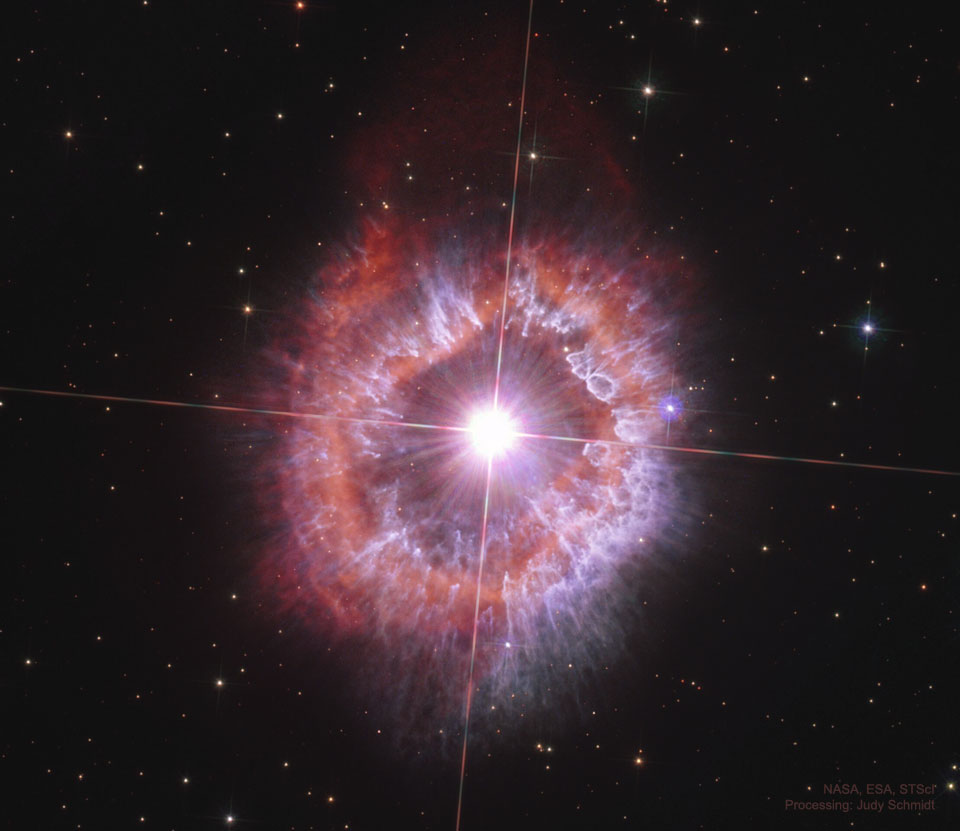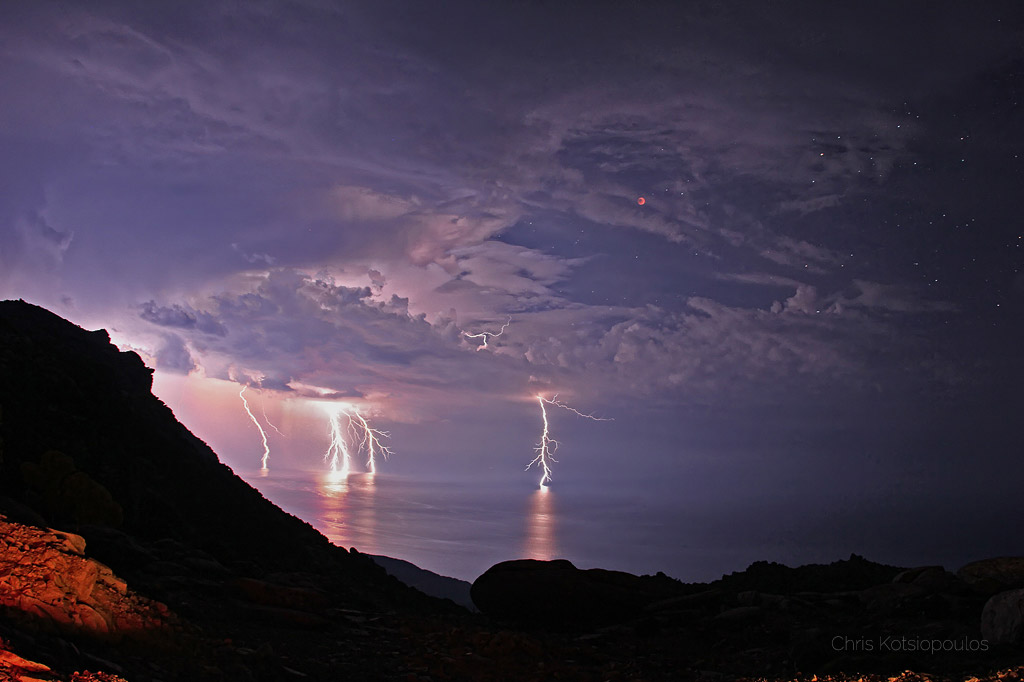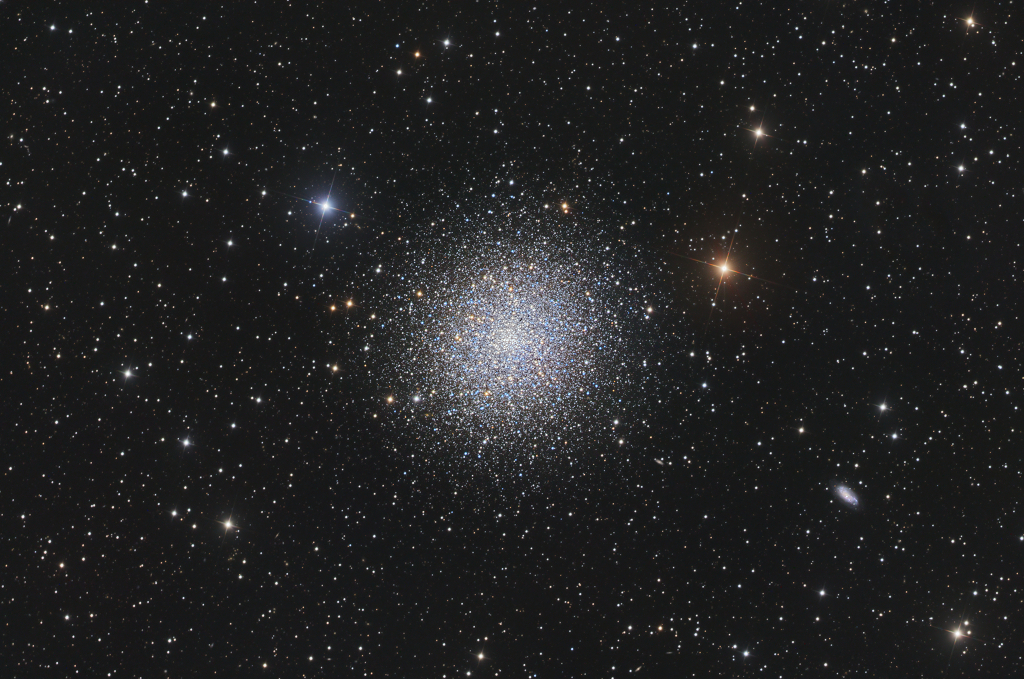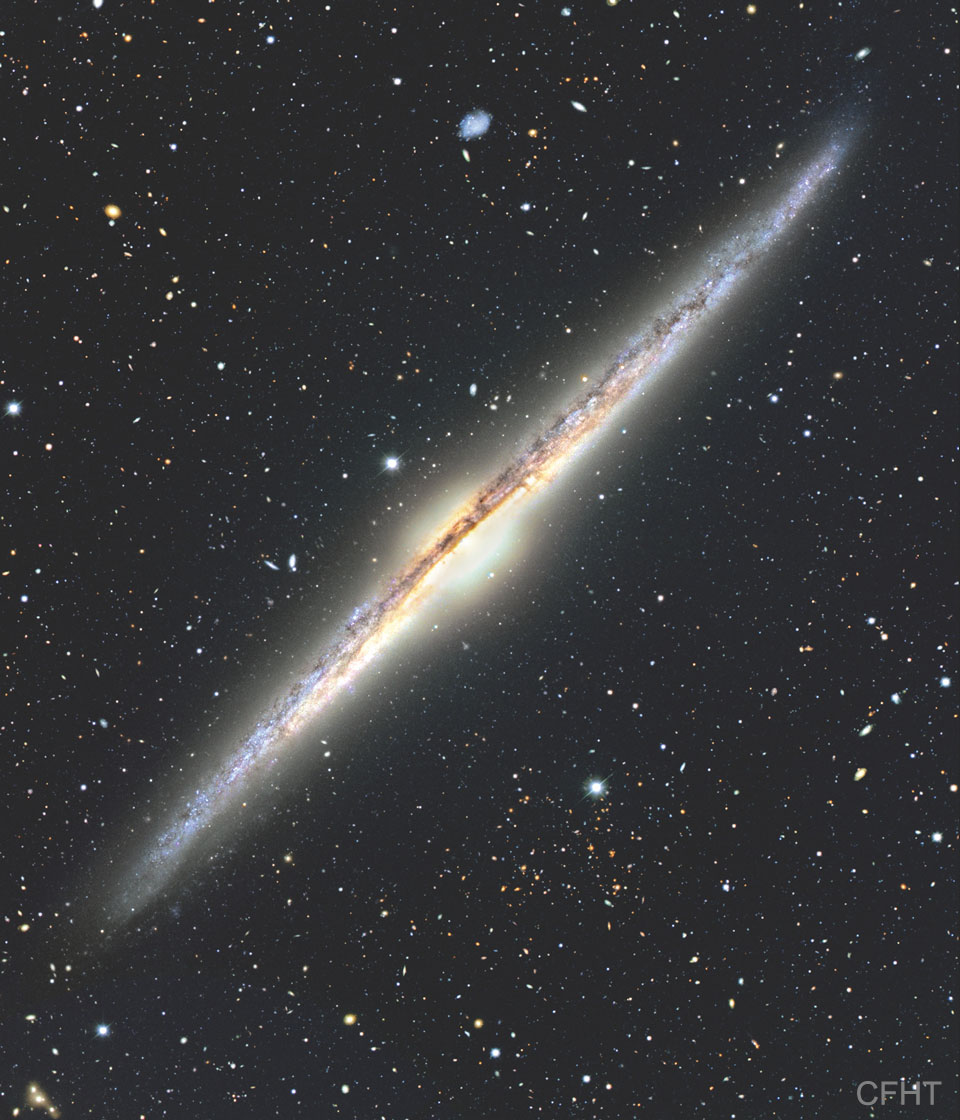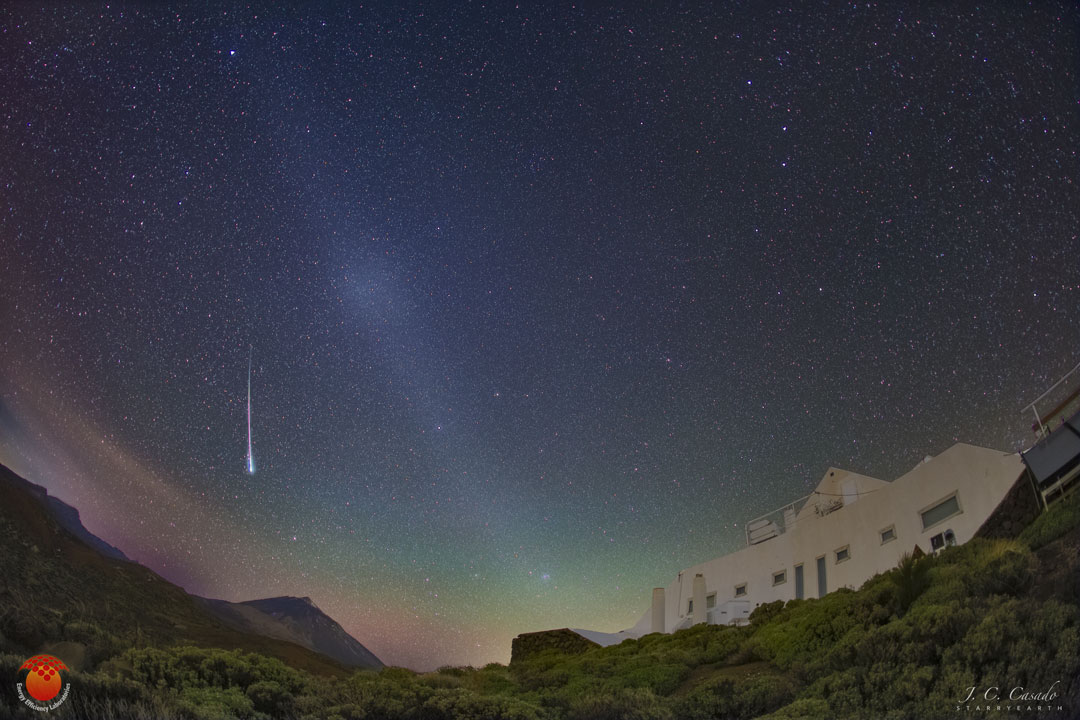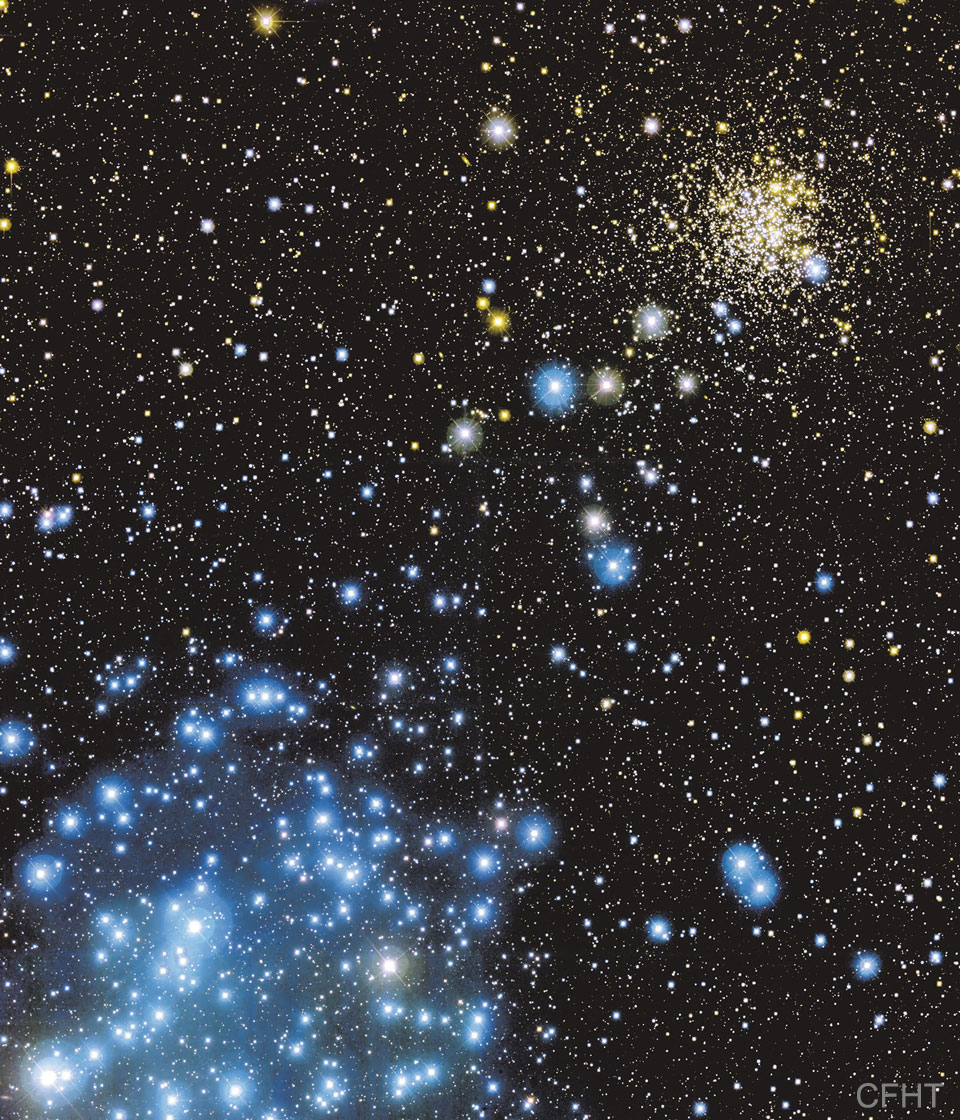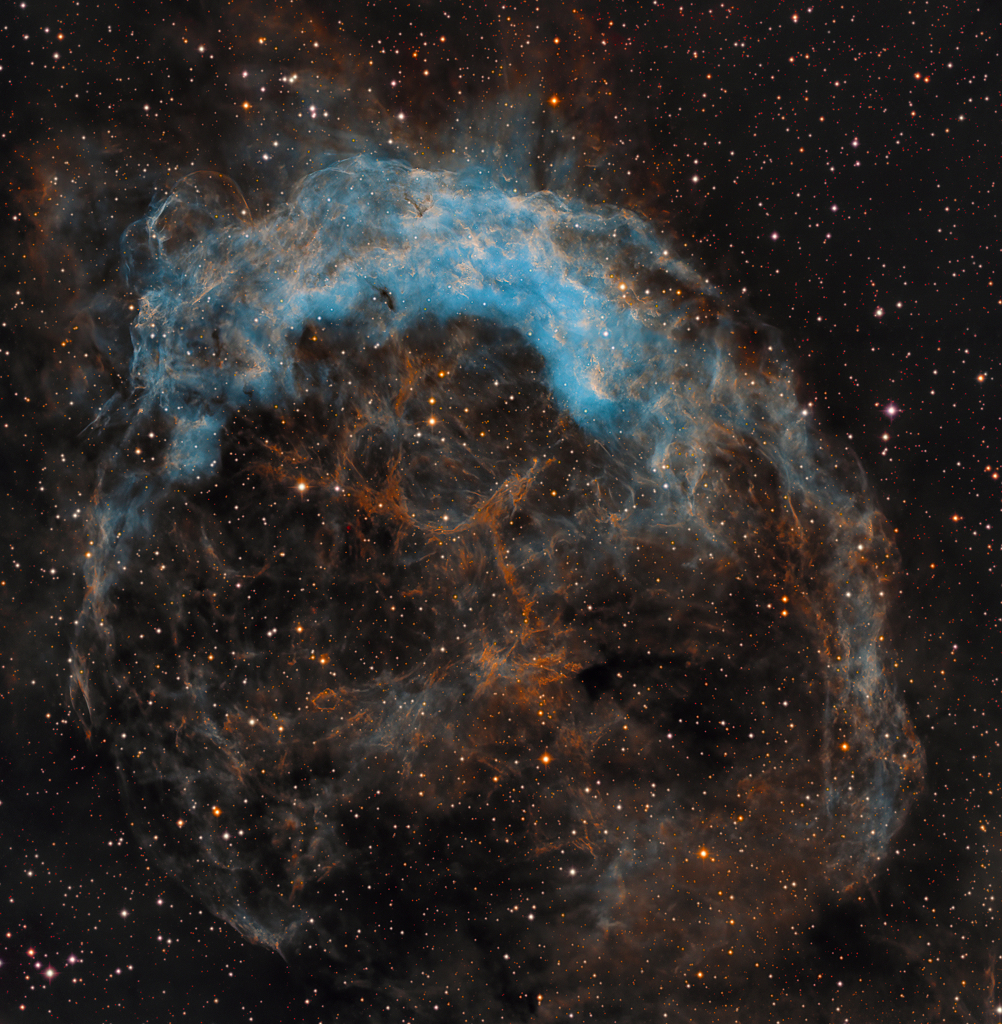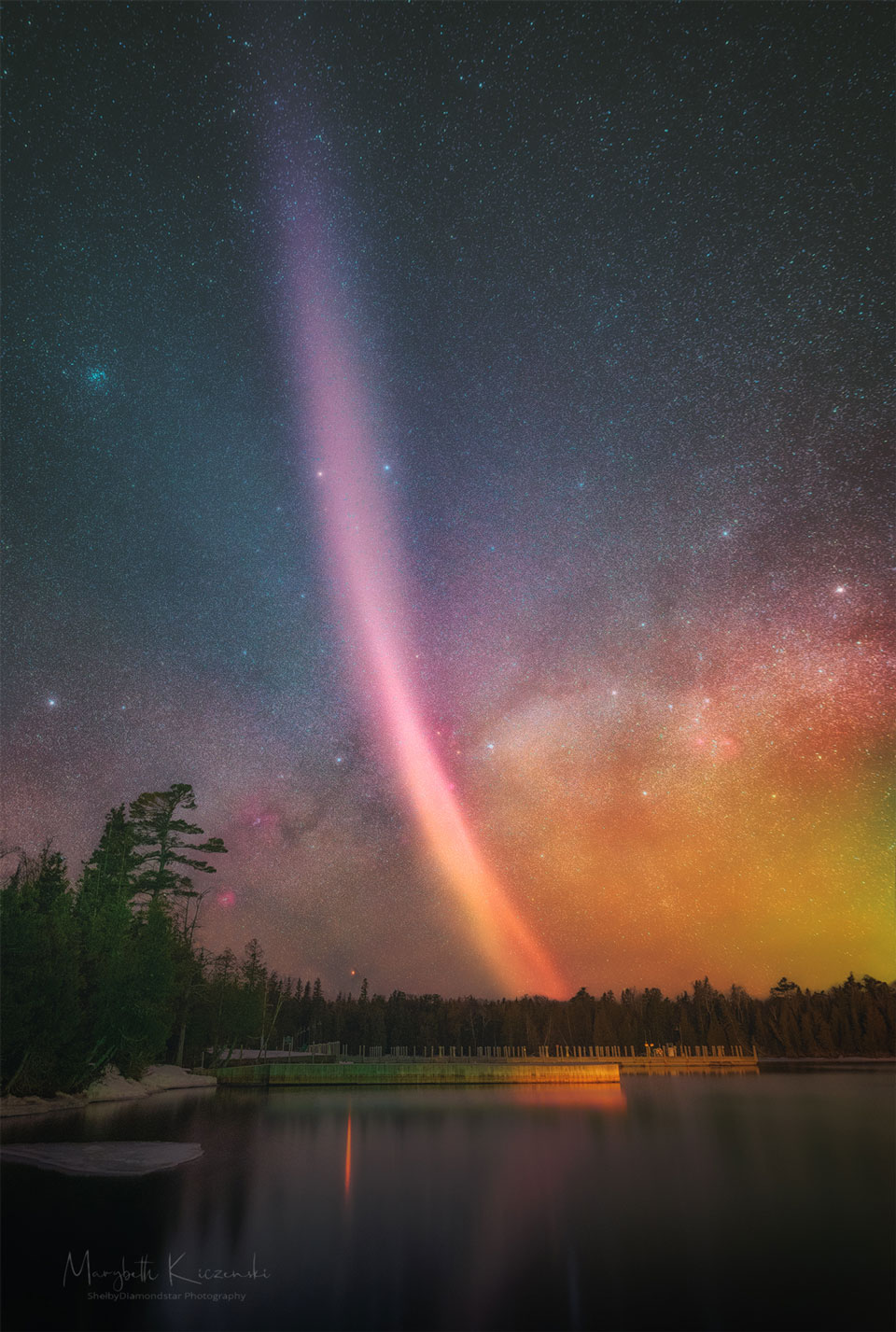Nombre total de pages vues
31/05/2021
I-PHONE ASTUCES - Secouez-moi...
ASTRONOMY - Mimas: Small Moon with a Big Crater
2021 May 31
Image Credit & Copyright: NASA, JPL-Caltech, Space Science Institute, Cassini
Explanation: Whatever hit Mimas nearly destroyed it. What remains is one of the largest impact craters on one of Saturn's smallest round moons. Analysis indicates that a slightly larger impact would have destroyed Mimas entirely. The huge crater, named Herschel after the 1789 discoverer of Mimas, Sir William Herschel, spans about 130 kilometers and is featured here. Mimas' low mass produces a surface gravity just strong enough to create a spherical body but weak enough to allow such relatively large surface features. Mimas is made of mostly water ice with a smattering of rock - so it is accurately described as a big dirty snowball. The featured image was taken during the closest-ever flyby of the robot spacecraft Cassini past Mimas in 2010 while in orbit around Saturn.
30/05/2021
29/05/2021
OVNIS - Des ovnis harcelant un navire de l’US Navy filmés sur un écran radar
ASTRONOMY - Lunar Dust and Duct Tape
2021 May 29
Image Credit: Apollo 17, NASA
Explanation: Why is the Moon so dusty? On Earth, rocks are weathered by wind and water, creating soil and sand. On the Moon, the history of constant micrometeorite bombardment has blasted away at the rocky surface creating a layer of powdery lunar soil or regolith. For the Apollo astronauts and their equipment, the pervasive, fine, gritty dust was definitely a problem. On the lunar surface in December 1972, Apollo 17 astronauts Harrison Schmitt and Eugene Cernan needed to repair one of their rover's fenders in an effort to keep the rooster tails of dust away from themselves and their gear. This picture reveals the wheel and fender of their dust covered rover along with the ingenious application of spare maps, clamps, and a grey strip of "duct tape".
27/05/2021
SANTE/MEDECINE - Attestation de vaccination
Si vous été vacciné contre la Covid-19 récemment, on vous a en principe donné à l'issue de l'injection une attestation imprimée comportant plusieurs informations (nom et prénom, type de vaccin, date de la première injection, etc.) ainsi qu'un QR Code. Code que vous pouvez utiliser pour enregistrer l'attestation dans le carnet de tests de l'application TousAntiCovid, qui centralise également les certificats de tests de dépistage. L'attestation de vaccination sera notamment utile pour le Pass sanitaire, ce "passeport" que le Gouvernement a décidé de mettre place à compter du 9 juin 2021, date de réouverture de nombreux établissements recevant du public, et qui permettra à la fois d'accéder à des manifestations et des événements regroupant plus de 1 000 personnes (spectacles, festivals, rencontres sportives, parcs à thèmes, foires, salons, etc.) et à faciliter le passage des frontières, pour les voyages professionnels ou les vacances (pour en savoir plus sur le Pass sanitaire, consultez la page de questions-réponses sur le site Web du Gouvernement).
ASTRONOMY - The Outburst Clouds of Star AG Car
2021 May 26
Image Credit: NASA, ESA, STScI; Processing: Judy Schmidt; Text: Anders Nyholm
Explanation: What created these unusual clouds? At the center of this 2021 Hubble image, processed by Judy Schmidt, sits AG Carinae, a supergiant star located about 20,000 light-years away in the southern constellation Carina. The star's emitted power is over a million times that of the Sun, making AG Carinae one of the most luminous stars in our Milky Way galaxy. AG Carinae and its neighbor Eta Carinae belong to the scarce Luminous Blue Variable (LBV) class of stars, known for their rare but violent eruptions. The nebula that surrounds AG Car is interpreted as a remnant of one or more such outbursts. This nebula measures 5 light-years across, is estimated to contain about 10 solar masses of gas, and to be at least 10,000 years old. This Hubble image, taken to commemorate Hubble's 31st launch anniversary, is the first to capture the whole nebula, offering a new perspective on its structure and dust content. The LBVs represent a late and short stage in the lives of some supergiant stars, but explaining their restlessness remains a challenge to humanity's understanding of how massive stars work.
25/05/2021
ASTRONOMY - The Moon During a Total Lunar Eclipse
2021 May 25
Video Credit: Wang Letian & Zhang Jiajie
Explanation: How does the Moon's appearance change during a total lunar eclipse? The featured time-lapse video was digitally processed to keep the Moon bright and centered during the 5-hour eclipse of 2018 January 31. At first the full moon is visible because only a full moon can undergo a lunar eclipse. Stars move by in the background because the Moon orbits the Earth during the eclipse. The circular shadow of the Earth is then seen moving across the Moon. The light blue hue of the shadow's edge is related to why Earth's sky is blue, while the deep red hue of the shadow's center is related to why the Sun appears red when near the horizon. Tomorrow, people living from southeast Asia, across the Pacific, to the southwest Americas may get to see a Blood Supermoon Total Lunar Eclipse. Here the term blood refers to the (likely) red color of the fully eclipsed Moon, while the term supermoon indicates the Moon's slightly high angular size -- due to being relatively close to the Earth in its slightly elliptical orbit.
PRATIQUE - Ouvrir une boîte de conserve sans ouvre-boîte
24/05/2021
ASTRONOMY - Lightning Eclipse from the Planet of the Goats
2021 May 24
Image Credit & Copyright: Chris Kotsiopoulos (GreekSky)
Explanation: Thunderstorms almost spoiled this view of the spectacular 2011 June 15 total lunar eclipse. Instead, storm clouds parted for 10 minutes during the total eclipse phase and lightning bolts contributed to the dramatic sky. Captured with a 30-second exposure the scene also inspired one of the more memorable titles (thanks to the astrophotographer) in APOD's now 25-year history. Of course, the lightning reference clearly makes sense, and the shadow play of the dark lunar eclipse was widely viewed across planet Earth in Europe, Africa, Asia, and Australia. The picture itself, however, was shot from the Greek island of Ikaria at Pezi. That area is known as "the planet of the goats" because of the rough terrain and strange looking rocks. The next total lunar eclipse will occur on Wednesday.
22/05/2021
ASTRONOMY - Markarian's Chain
2021 May 22
Image Credit & Copyright: Ginge Anvik
Explanation: Near the heart of the Virgo Galaxy Cluster the string of galaxies known as Markarian's Chain stretches across this deep telescopic field of view. Anchored in the frame at bottom center by prominent lenticular galaxies, M84 (bottom) and M86, you can follow the chain up and to the right. Near center you'll spot the pair of interacting galaxies NGC 4438 and NGC 4435, known to some as Markarian's Eyes. Its center an estimated 50 million light-years distant, the Virgo Cluster itself is the nearest galaxy cluster. With up to about 2,000 member galaxies, it has a noticeable gravitational influence on our own Local Group of Galaxies. Within the Virgo Cluster at least seven galaxies in Markarian's Chain appear to move coherently, although others may appear to be part of the chain by chance.
21/05/2021
PRATIQUE/POURQUOI - Pourquoi n'avons-nous pas tous la même couleur de peau ?
20/05/2021
ASTRONOMY - M13: The Great Globular Cluster in Hercules
2021 May 20
Image Credit & Copyright: Martin Dufour
Explanation: In 1716, English astronomer Edmond Halley noted, "This is but a little Patch, but it shews itself to the naked Eye, when the Sky is serene and the Moon absent." Of course, M13 is now less modestly recognized as the Great Globular Cluster in Hercules, one of the brightest globular star clusters in the northern sky. Sharp telescopic views like this one reveal the spectacular cluster's hundreds of thousands of stars. At a distance of 25,000 light-years, the cluster stars crowd into a region 150 light-years in diameter. Approaching the cluster core upwards of 100 stars could be contained in a cube just 3 light-years on a side. For comparison, the closest star to the Sun is over 4 light-years away. The remarkable range of brightness recorded in this image follows stars into the dense cluster core. Distant background galaxies in the medium-wide field of view include NGC 6207 at the lower right.
19/05/2021
I-PHONE ASTUCES - Selfie facile
ASTRONOMY - The Jellyfish and Mars
2021 May 19
Image Credit & Copyright: Jason Guenzel
Explanation: Normally faint and elusive, the Jellyfish Nebula is caught in this alluring scene. In the telescopic field of view two bright yellowish stars, Mu and Eta Geminorum, stand just below and above the Jellyfish Nebula at the left. Cool red giants, they lie at the foot of the celestial twin. The Jellyfish Nebula itself floats below and left of center, a bright arcing ridge of emission with dangling tentacles. In fact, the cosmic jellyfish is part of bubble-shaped supernova remnant IC 443, the expanding debris cloud from a massive star that exploded. Light from that explosion first reached planet Earth over 30,000 years ago. Like its cousin in astrophysical waters the Crab Nebula supernova remnant, the Jellyfish Nebula is known to harbor a neutron star, the remnant of the collapsed stellar core. Composed on April 30, this telescopic snapshot also captures Mars. Now wandering through early evening skies, the Red Planet also shines with a yellowish glow on the right hand side of the field of view. Of course, the Jellyfish Nebula is about 5,000 light-years away, while Mars is currently almost 18 light-minutes from Earth.
18/05/2021
ASTRONOMY - Jets from the Necklace Nebula
2021 May 18
Image Credit: ESA, Hubble, NASA; Processing: K. Noll
Explanation: What celestial body wears the Necklace Nebula? First, analyses indicate that the Necklace is a planetary nebula, a gas cloud emitted by a star toward the end of its life. Also, what appears to be diamonds in the Necklace are actually bright knots of glowing gas. In the center of the Necklace Nebula are likely two stars orbiting so close together that they share a common atmosphere and appear as one in the featured image by the Hubble Space Telescope. The red-glowing gas clouds on the upper left and lower right are the results of jets from the center. Exactly when and how the bright jets formed remains a topic of research. The Necklace Nebula is only about 5,000 years old, spans about 5 light years, and can best be found with a large telescope toward the direction of the constellation of the Arrow (Sagitta).
SANTE/MEDECINE - Covid-19 : la décrue de l'épidémie se poursuit en France
17/05/2021
ASTRONOMY - NGC 4565: Galaxy on Edge
2021 May 17
Image Credit & Copyright: CFHT, Coelum, MegaCam, J.-C. Cuillandre (CFHT) & G. A. Anselmi (Coelum)
Explanation: Is our Milky Way Galaxy this thin? Magnificent spiral galaxy NGC 4565 is viewed edge-on from planet Earth. Also known as the Needle Galaxy for its narrow profile, bright NGC 4565 is a stop on many telescopic tours of the northern sky, in the faint but well-groomed constellation Coma Berenices. This sharp, colorful image reveals the spiral galaxy's boxy, bulging central core cut by obscuring dust lanes that lace NGC 4565's thin galactic plane. An assortment of other background galaxies is included in the pretty field of view. Thought similar in shape to our own Milky Way Galaxy, NGC 4565 lies about 40 million light-years distant and spans some 100,000 light-years. Easily spotted with small telescopes, sky enthusiasts consider NGC 4565 to be a prominent celestial masterpiece Messier missed.
15/05/2021
ESPACE - Aterrisage en Mars - Succés de la Chine
14/05/2021
I-PHONE ASTUCES - Recharger l'iPhone 2 fois plus vite
ASTRONOMY - M104: The Sombrero Galaxy
Image Credit & Copyright: Bray Falls
Explanation: A gorgeous spiral galaxy, M104 is famous for its nearly edge-on profile featuring a broad ring of obscuring dust lanes. Seen in silhouette against an extensive central bulge of stars, the swath of cosmic dust lends a broad brimmed hat-like appearance to the galaxy suggesting a more popular moniker, the Sombrero Galaxy. This sharp optical view of the well-known galaxy made from ground-based image data was processed to preserve details often lost in overwhelming glare of M104's bright central bulge. Also known as NGC 4594, the Sombrero galaxy can be seen across the spectrum, and is host to a central supermassive black hole. About 50,000 light-years across and 28 million light-years away, M104 is one of the largest galaxies at the southern edge of the Virgo Galaxy Cluster. Still the colorful spiky foreground stars in this field of view lie well within our own Milky Way galaxy.
PRATIQUE/POURQUOI - Pourquoi l'oignon nous fait-il pleurer ?
13/05/2021
I-PHONE ASTUCES - Arrêter la musique avec le minuteur
ASTRONOMY - The Comet, the Whale, and the Hockey Stick
2021 May 13
Image Credit & Copyright: Grand Mesa Observatory, Terry Hancock / Tom Masterson
Explanation: Closest to the Sun on March 1, and closest to planet Earth on April 23, this Comet ATLAS (C/2020 R4) shows a faint greenish coma and short tail in this pretty, telescopic field of view. Captured at its position on May 5, the comet was within the boundaries of northern constellation Canes Venatici (the Hunting Dogs), and near the line-of-sight to intriguing background galaxies popularly known as the Whale and the Hockey Stick. Cetacean in appearance but Milky Way sized, NGC 4631 is a spiral galaxy seen edge-on at the top right, some 25 million light-years away. NGC 4656/7 sports the bent-stick shape of interacting galaxies below and left of NGC 4631. In fact, the distortions and mingling trails of gas detected at other wavelengths suggest the cosmic Whale and Hockey Stick have had close encounters with each other in their distant past. Outbound and only about 7 light-minutes from Earth this Comet ATLAS should revisit the inner solar system in just under 1,000 years.
12/05/2021
I-PHONE ASTUCES - Utiliser Google Maps SANS Connexion
ASTRONOMY - A Meteor and the Gegenschein
2021 May 12
Image Credit: J.C. Casado, StarryEarth, EELabs, TWAN
Explanation: Is the night sky darkest in the direction opposite the Sun? No. In fact, a rarely discernable faint glow known as the gegenschein (German for "counter glow") can be seen 180 degrees around from the Sun in an extremely dark sky. The gegenschein is sunlight back-scattered off small interplanetary dust particles. These dust particles are millimeter sized splinters from asteroids and orbit in the ecliptic plane of the planets. Pictured here from last March is one of the more spectacular pictures of the gegenschein yet taken. The deep exposure of an extremely dark sky over Teide Observatory in Spain's Canary Islands shows the gegenschein as part of extended zodiacal light. Notable background objects include a bright meteor (on the left), the Big Dipper (top right), and Polaris (far right). The meteor nearly points toward Mount Teide, Spain's highest mountain, while the Pyramid solar laboratory is visible on the right. During the day, a phenomenon like the gegenschein called the glory can be seen in reflecting air or clouds opposite the Sun from an airplane.
11/05/2021
I-PHONE ASTUCES - Prendre une photo avec le bouton du volume
ASTRONOMY - Lightning and Orion Beyond Uluru
2021 May 11
Image Credit & Copyright: Park Liu
Explanation: What's happening behind Uluru? A United Nations World Heritage Site, Uluru is an extraordinary 350-meter high mountain in central Australia that rises sharply from nearly flat surroundings. Composed of sandstone, Uluru has slowly formed over the past 300 million years as softer rock eroded away. In the background of the featured image taken in mid-May, a raging thunderstorm is visible. Far behind both Uluru and the thunderstorm is a star-filled sky highlighted by the constellation of Orion. The Uluru region has been a home to humans for over 22,000 years. Local indigenous people have long noted that when the stars that compose the modern constellation of Orion first appear in the night sky, a hot season involving lightning storms will soon be arriving.
10/05/2021
ASTRONOMY - Star Clusters M35 and NGC 2158
2021 May 10
Image Credit & Copyright: CFHT, Coelum, MegaCam, J.-C. Cuillandre (CFHT) & G. A. Anselmi (Coelum)
Explanation: Clusters of stars can be near or far, young or old, diffuse or compact. The featured image shows two quite contrasting open star clusters in the same field. M35, on the lower left, is relatively nearby at 2800 light years distant, relatively young at 150 million years old, and relatively diffuse, with about 2500 stars spread out over a volume 30 light years across. Bright blue stars frequently distinguish younger open clusters like M35. Contrastingly, NGC 2158, on the upper right, is four times more distant than M35, over 10 times older, and much more compact. NGC 2158's bright blue stars have self-destructed, leaving cluster light to be dominated by older and yellower stars. In general, open star clusters are found in the plane of our Milky Way Galaxy, and contain anywhere from 100 to 10,000 stars -- all of which formed at nearly the same time. Both open clusters M35 and NGC 2158 can be found together with a small telescope toward the constellation of the Twins (Gemini).
09/05/2021
PRATIQUE/POURQUOI - Pourquoi la Louisiane se nomme t-elle ainsi ?
08/05/2021
ASTRONOMY - Deepscape at Yacoraite
2021 May 8
Image Credit & Copyright: Franco Meconi
Explanation: In this evocative night scene a dusty central Milky Way rises over the ancient Andean archaeological site of Yacoraite in northwestern Argentina. The denizens of planet Earth reaching skyward are the large Argentine saguaro cactus currently native to the arid region. The unusual yellow-hued reflection nebula above is created by dust scattering starlight around red giant star Antares. Alpha star of the constellation Scorpius, Antares is over 500 light-years distant. Next to it bright blue Rho Ophiuchi is embedded in more typical dusty bluish reflection nebulae though. The deep night skyscape was created from a series of background exposures of the rising stars made while tracking the sky, and a foreground exposure of the landscape made with the camera and lens fixed on the tripod. In combination they produce the single stunning image and reveal a range of brightness and color that your eye can't quite perceive on its own.
07/05/2021
ASTRONOMY - Mercury-Redstone 3 Launch
2021 May 7
Image Credit: NASA
Explanation: Sixty years ago, near the dawn of the space age, NASA controllers "lit the candle" and sent Mercury astronaut Alan Shepard arcing into space atop a Redstone rocket. His cramped space capsule was dubbed Freedom 7. Broadcast live to a global television audience, the historic Mercury-Redstone 3 (MR-3) spacecraft was launched from Cape Canaveral Florida at 9:34 a.m. Eastern Time on May 5, 1961. The flight of Freedom 7, the first space flight by an American, followed less than a month after the first human venture into space by Soviet Cosmonaut Yuri Gagarin. The 15 minute sub-orbital flight achieved an altitude of 116 miles and a maximum speed of 5,134 miles per hour. As Shepard looked back near the peak of Freedom 7's trajectory, he could see the outlines of the west coast of Florida, Lake Okeechobe in central Florida, the Gulf of Mexico, and the Bahamas. Shepard would later view planet Earth from a more distant perspective and walk on the Moon as commander of the Apollo 14 mission.
06/05/2021
ASTRONOMY - Windblown NGC 3199
2021 May 6
Image Credit & Copyright: Mike Selby and Roberto Colombari
Explanation: NGC 3199 lies about 12,000 light-years away, a glowing cosmic cloud in the nautical southern constellation of Carina. The nebula is about 75 light-years across in this narrowband, false-color view. Though the deep image reveals a more or less complete bubble shape, it does look very lopsided with a much brighter edge along the top. Near the center is a Wolf-Rayet star, a massive, hot, short-lived star that generates an intense stellar wind. In fact, Wolf-Rayet stars are known to create nebulae with interesting shapes as their powerful winds sweep up surrounding interstellar material. In this case, the bright edge was thought to indicate a bow shock produced as the star plowed through a uniform medium, like a boat through water. But measurements have shown the star is not really moving directly toward the bright edge. So a more likely explanation is that the material surrounding the star is not uniform, but clumped and denser near the bright edge of windblown NGC 3199.
05/05/2021
ASTRONOMY - STEVE over Copper Harbor
Image Credit & Copyright: MaryBeth Kiczenski
Explanation: What creates STEVEs? Strong Thermal Emission Velocity Enhancements (STEVEs) have likely been seen since antiquity, but only in the past five years has it been realized that their colors and shapes make them different from auroras. Seen as single bright streaks of pink and purple, the origin of STEVEs remain an active topic of research. STEVEs may be related to subauroral ion drifts (SAIDs), a supersonic river of hot atmospheric ions. For reasons currently unknown, STEVEs are frequently accompanied by green "picket-fence" auroras. The featured STEVE image is a combination of foreground and background exposures taken consecutively in mid-March from Copper Harbor, Michigan, USA. This bright STEVE lasted several minutes, spanned from horizon to horizon, and appeared in between times of normal auroras.
04/05/2021
ASTRONOMY - Apollo 11: Earth, Moon, Spaceship
2021 May 4
Image Credit: NASA, Apollo 11; Restoration - Toby Ord
Explanation: After the most famous voyage of modern times, it was time to go home. After proving that humanity has the ability to go beyond the confines of planet Earth, the first humans to walk on another world -- Neil Armstrong and Buzz Aldrin -- flew the ascent stage of their Lunar Module back to meet Michael Collins in the moon-orbiting Command and Service Module. Pictured here on 1969 July 21 and recently digitally restored, the ascending spaceship was captured by Collins making its approach, with the Moon below, and Earth far in the distance. The smooth, dark area on the lunar surface is Mare Smythii located just below the equator on the extreme eastern edge of the Moon's near side. It is said of this iconic image that every person but one was in front of the camera.
02/05/2021
ASTRONOMY - Clouds of the Carina Nebula
Image Credit & Copyright: John Ebersole
Explanation: What forms lurk in the mists of the Carina Nebula? The dark ominous figures are actually molecular clouds, knots of molecular gas and dust so thick they have become opaque. In comparison, however, these clouds are typically much less dense than Earth's atmosphere. Featured here is a detailed image of the core of the Carina Nebula, a part where both dark and colorful clouds of gas and dust are particularly prominent. The image was captured in mid-2016 from Siding Spring Observatory in Australia. Although the nebula is predominantly composed of hydrogen gas -- here colored green, the image was assigned colors so that light emitted by trace amounts of sulfur and oxygen appear red and blue, respectively. The entire Carina Nebula, cataloged as NGC 3372, spans over 300 light years and lies about 7,500 light-years away in the constellation of Carina. Eta Carinae, the most energetic star in the nebula, was one of the brightest stars in the sky in the 1830s, but then faded dramatically.
01/05/2021
ASTRONOMY - Perseverance from Ingenuity
2021 May 1
Image Credit: NASA, JPL-Caltech, Ingenuity
Explanation: Flying at an altitude of 5 meters (just over 16 feet), on April 25 the Ingenuity helicopter snapped this sharp image. On its second flight above the surface of Mars, its color camera was looking back toward Ingenuity's current base at Wright Brothers Field and Octavia E. Butler Landing marked by the tracks of the Perseverance rover at the top of the frame. Perseverance itself looks on from the upper left corner about 85 meters away. Tips of Ingenuity's landing legs just peek over the left and right edges of the camera's field of view. Its record setting fourth flight completed on April 30, Ingenuity collected images of a potential new landing zone before returning to Wright Brothers Field. Ingenuity's fifth flight would be one-way though as the Mars aircraft moves on to the new airfield, anticipating a new phase of operational demonstration flights.
ASTRONOMY - Orion and the Ocean of Storms
2025 December 13 Orion and the Ocean of Storms Image Credit: NASA , Artemis 1 Explanation: On December 5, 2022, a camera on board the u...

-
2022 September 26 All the Water on Planet Earth Illustration Credit: Jack Cook, Adam Nieman, Woods Hole Oceanographic Institution ; Data ...
-
2025 May 11 The Surface of Venus from Venera 14 Image Credit: Soviet Planetary Exploration Program , Venera 14 ; Processing & Copyri...





